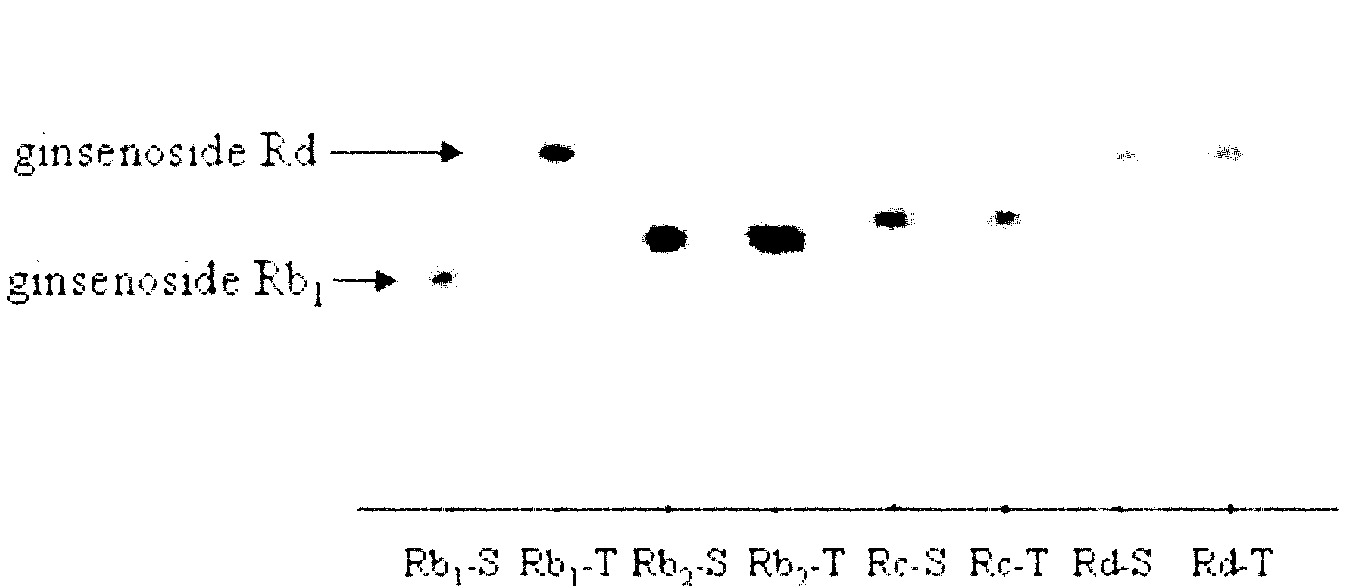Ginseng endogenesis zygorhynchus moelleri mildew as well as method for preparing ginsenoside Rd by utilizing same
A technology of mollerian inoculation mold and ginsenoside, applied in the direction of fungi, fermentation, etc., can solve the problems of high ginsenoside concentration, low yield, prolonged reaction time, etc., and achieve cost-free by-products, simple and convenient, specific effect
- Summary
- Abstract
- Description
- Claims
- Application Information
AI Technical Summary
Problems solved by technology
Method used
Image
Examples
Embodiment 1
[0030] Embodiment 1: Isolation and screening of bacterial strains
[0031]1. Isolation of endophytic bacteria from ginseng: select fresh and healthy ginseng, wash it with tap water, soak it in 0.1% mercury liter for 1-1.5 minutes, rinse it with sterile water for 4-5 times; Soak in 75% alcohol for 1 to 1.5 minutes, and rinse with sterile water for 3 to 4 times. Under sterile conditions, ginseng roots were cut into small pieces (2mm×2mm) with sterilized surgical scissors, and placed on PDA plates with a diameter of 9cm. After 5-7 days, observe whether there are colonies formed around the tissue block, and pick endophytic fungal hyphae and inoculate them on PDA slant medium for purification and preservation.
[0032] Medium: potato dextrose agar medium (PDA medium): 200 g of potatoes, 18 g of glucose, 18 g of agar, 1000 mL.
[0033] The ginseng (Panax ginseng C.A.Mey) used in this example was obtained by self-collection, and was collected by the inventor from Huanren County, Li...
Embodiment 2
[0043] Embodiment 2: conversion singleness test
[0044] Adopt the method of embodiment 1 step 2 (2), the conversion selectivity of ginsenoside substrate and product of the mollerian mold (CGMCCNo.4315) obtained by test screening, through TLC detection, the result is as attached image 3 Shown:
[0045] It can be seen that the protodiol saponin Rb 1 , Rb 2 . 1 A reaction occurs, and the conversion product is only one, and the product can be preliminarily judged to be Rd according to the Rf value. It has good substrate selectivity and product singleness.
Embodiment 3
[0046] Embodiment 3: solid conversion method prepares Rd
[0047] ① Prepare solid transformation medium (PDA): every 100mL medium contains 20g of potato, 1.8g of glucose, 1.8g of agar, and ginsenoside Rb 1 20g; prepared with deionized water, sterilized under 1.0kPa autoclave at 121°C for 30min.
[0048] ② Inoculate the activated Molderella mollerii (CGMCC No.4315) to the above-mentioned ginsenoside Rb-containing 1 cultured on PDA medium at 25°C for 5-7 days.
[0049] ③Product extraction and separation: Soak the culture in n-butanol and extract fully; the extract is centrifuged at 10000r / min for 1min, filtered through a microporous membrane with a diameter of 0.22μm, and the target product is separated by HPLC.
[0050] HPLC conditions: flow rate: 0.6mL / min; detection wavelength: 203nm; column temperature 35°C; mobile phase: A is acetonitrile, B is high-purity water;
[0051] Gradient elution mobile phase ratio:
[0052] 0min, A is 20%, B is 80%;
[0053] 18min, A is 40%, ...
PUM
 Login to View More
Login to View More Abstract
Description
Claims
Application Information
 Login to View More
Login to View More - Generate Ideas
- Intellectual Property
- Life Sciences
- Materials
- Tech Scout
- Unparalleled Data Quality
- Higher Quality Content
- 60% Fewer Hallucinations
Browse by: Latest US Patents, China's latest patents, Technical Efficacy Thesaurus, Application Domain, Technology Topic, Popular Technical Reports.
© 2025 PatSnap. All rights reserved.Legal|Privacy policy|Modern Slavery Act Transparency Statement|Sitemap|About US| Contact US: help@patsnap.com



